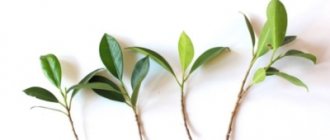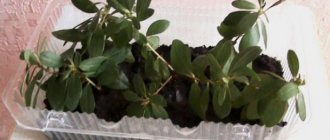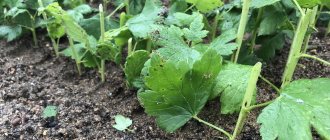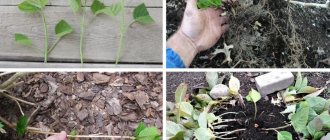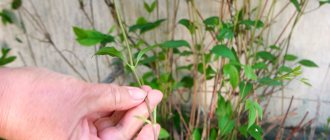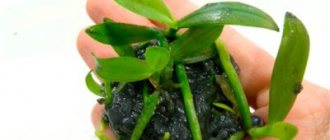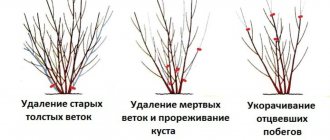Almost everyone loves indoor beauties azaleas, because they delight with their flowering when most plants are already resting. Growing an entire flowering window sill is quite easy if you use the cutting method. Unlike the seed propagation method, it will give results in a shorter time.
You can start cutting azaleas from July to October.
Azalea propagation technology
Cuttings
The cuttings are cut with a blade or a sharp knife, previously disinfected with alcohol or a solution of potassium permanganate.
Suitable cuttings are selected (see above), and the leaves at the bottom are torn off. The cut is made obliquely, at an angle of 45˚, 1 cm down from the lower bud. In order for the cuttings to take root better, they must be soaked in one of the rooting preparations. Expanded clay is poured into the prepared pots or tray with a layer of 2 cm, then a layer of sand is 1 cm, and soil for azaleas is laid on top. When planting, shoots should be deepened by 2-3 cm, compacting the soil around with your fingers. Water the seedlings thoroughly. Be sure to build a “mini-greenhouse” so that the film does not touch the cuttings. (see video)
It is important! For the best rooting of cuttings, it is necessary to spray, provide oxygen (ventilation) and the room temperature should be at least 22-25˚C.
Seeds
The tray and soil mixture are prepared in the same way as for cuttings. The seeds are laid out on the surface of the soil and sprayed thoroughly. The tray is covered with glass or film and placed in a bright place. It is necessary to regularly ventilate the crops and spray them with water softened with a few drops of lemon juice. When the first shoots appear, the film should be removed immediately. When the first leaves appear on the seedlings, the seedlings dive into small pots with azalea substrate.
Remember! An azalea seed germinates only in the light!
Vaccination
One cutting of an azalea variety that is difficult to take root (scion) is carefully selected. An easily rooted azalea variety is used as a rootstock. The rootstock branch is cut so that the thickness of the cuts coincides. The grafting parts are combined and securely fixed. A “mini greenhouse” is installed above the plant, and the plant is shaded for the first time. After grafting, the seedling must be carefully looked after so that the cuts grow together safely. The connected parts must not be damaged. Reproduction of azaleas by grafting is a rather difficult operation that requires certain skills.
Dividing the bush
The plant is immersed in water for 15 minutes so that the soil is well saturated with moisture, and the water is allowed to drain for some time. Using a sharp, disinfected knife, divide the bush into 3-4 parts, trying to preserve part of the root system in each division. When the roots are intertwined, they are carefully untangled by hand. Part of the plant with a lump of earth is placed in small pots with a diameter of no more than 5 mm to prevent the roots from rotting.
The cuttings are planted at the same level as they were before planting. The voids are filled with disinfected soil. A prerequisite is drainage at the bottom of the pots. After a year, the bushes are transplanted into pots of larger diameter. When transshipping, they try to preserve a lump of earth so as not to damage the root system.
Basic mistakes
- The first and most common mistake is failure to comply with the time interval for pruning the plant
. Azalea is a rather whimsical “green”; if you rush or overexpose it, it will be difficult for it to bloom. - The second mistake is neglecting the tool, or lack thereof
. Often housewives, having noticed a dried leaf, try to get rid of it using improvised means. And often they pull it out by the roots with bare hands. This is strictly prohibited. - The third mistake is ignorance of the basic rules of care after circumcision
. The cut areas must be carefully processed.
What is cuttings
How to propagate petunia by cuttings in spring
The method of vegetative propagation of a plant, when a part (cutting) separated from the parent plant is used, is called cuttings.
Important! By cuttings, new plants are obtained with the same species and varietal characteristics as those of the mother specimen. Other methods do not always give this effect
The cutting method has been used for plant propagation for about 150 years. This method is widely used in indoor floriculture and ornamental gardening, forestry, etc.
Propagation by stem cuttings is the main method of obtaining planting material for some fruit, berry and ornamental species (currants, grapes, etc.). This process of growing crops requires certain conditions. It is best to cut cuttings during active growth of shoots, and growth stimulants are used to quickly root cuttings.
There are several techniques for cutting cuttings, depending on the plant’s ability to root. This can be a cut at the internode, hammer-shaped, nodal, etc.).
General information about azalea
Rhododendron is a unique flower. This is one of those plant species that has existed on the planet for several tens of millions of years. In this case, the age of the culture is no less than 50 million years. Of course, the ancient ancestors of modern azaleas are plants that are somewhat more primitive and at the same time resistant to changing environmental conditions. Unfortunately, the high level of the body's defenses failed to prevent the death of a significant part of rhododendrons as a result of the onset of the Ice Age. Therefore, the habitats of plants differ in climatic and geographical characteristics. Modern azalea can be found in nature in the Land of the Rising Sun, the Himalayas, New Guinea, the Middle Kingdom, and northern Australia. In total, rhododendron today has at least a thousand species.
Externally, azalea looks very attractive
: due to evergreen foliage, neat shape and large graceful flowers with delicate petals and delightful colors. Rhododendron flowering lasts less than a month, but this process occurs in winter and early spring, when the heart asks for at least a grain of warmth. There are early, mid-late and late varieties of azaleas.
Rhododendron will help you treat certain diseases, such as stye, and restore visual acuity. In the first case, you need to make applications on closed eyelids from azalea leaves, and in the second, just admire the lush flowers for 20 - 30 minutes. A charming plant that deserves to decorate every home.
How to propagate azalea at home
The process of cutting a plant consists of three main stages. Let's look at each of them in detail.
Separation from the mother flower
When performing the procedure for separating a cutting from the mother plant, you should adhere to the following recommendations:
- All garden tools must be sterilized before use. This is done in order not to spread the infection from other plants.
- The branch for cutting is selected to be healthy and corresponding to the parameters specified for different types of azaleas.
- The cut of the cutting is made under the lower bud, with an indentation of 1 cm. The cut is made at an angle of 45 degrees, several lower leaves are removed.
- The resulting seedling is treated with the selected growth stimulant.
The following drugs can be used to stimulate growth:
- Heteroauxin - a fifth of the tablet dissolves in half a liter of water. Plant cuttings are dipped into the resulting mixture and kept there for no longer than 6 hours.
- Zircon - dispensed in liquid form, 10 drops are dissolved in the same volume of water. Soaking lasts longer - one day.
- Kornevin - in terms of application, it is radically different from previous drugs. The drug powder and activated carbon crushed to a dusty state are mixed in equal quantities. Then the sections are sprinkled.
Landing
Cuttings of azaleas at the planting stage require the following activities:
- Planting in the ground is not carried out without first soaking it in a root growth stimulator.
- Before the planting procedure, additional treatment of the sections is carried out with a weak solution of potassium permanganate.
- Planting is done in moist soil, with the cuttings deepened by 2-3 cm.
- The final step is to cover the frame with a plastic bag and dark cloth. This step should be performed if the dark rooting option was chosen.
How to root an azalea at home
To achieve successful growth of azalea roots, the improvised greenhouse should be placed in a warm place where direct sunlight does not reach.
In addition, certain conditions must be met:
- air temperature 22-25 degrees;
- humidity not lower than 80%;
- in the cold season, the soil is additionally heated using a battery or an incandescent lamp.
Further care consists of daily ventilation of the plant. The film is removed from it for 30-40 minutes, it is better to do this before noon. Instead of watering, spraying is performed; the soil should be constantly moist. Once every 7 days, citric or oxalic acid can be added to the water at the rate of 2 g per liter.
As many cuttings as possible should be rooted, since the chances of their further development are low. If 3-4 adult plants are obtained from 20 cuttings, this can be considered a success.
Care after root germination
If the recommendations on how to root an azalea from a cutting have been followed, and the plant has begun to grow (new leaves have appeared), then the care tactics need to be changed. Plants are planted in separate containers from a common tray, but before this a kind of hardening is performed. On the first day, the flower is left without film for two hours, with each subsequent day the time is increased by an hour and a half. After 6-7 days you can start transplanting.
Further care actions do not differ from those recommended for an adult plant. The only nuance is that if buds form on the azaleas immediately after transplantation, they must be cut off in order to preserve the flower’s strength for development.
Cutting an azalea is a very troublesome task, but it will have to be done if you want to propagate a beautiful flower. By following these tips and sequence you will be able to achieve success.
It is important to remember that only 1-2 cuttings out of 10 take root, so you need to plant as many shoots as possible. Considering the constant need for pruning and formation of an adult bush, there will be no shortage of planting material
Also read our article “How to revive an azalea if it has dried up.”
Flower diseases, treatment instructions
The effectiveness of treatment depends on how quickly and accurately the disease is diagnosed.
If the conditions of detention are violated, it is necessary to take measures to return the azalea to a comfortable living environment. Important! Infection with a bacterial, fungal or viral infection requires treatment with appropriate compounds, which are selected taking into account the existing symptoms.
Drying
The reason is a lack of moisture, light and fertilizers. Treatment involves removing dried parts of the azalea and creating the necessary conditions (what to do if an indoor azalea has dried out?).
Yellowing
The most common cause is exposure to direct sunlight and placing the plant in a room with too dry air. To normalize the condition of the bush, it is enough to eliminate the negative factor.
If clay is detected in the soil, replanting is necessary.
Read about the main reasons why rhododendron leaves, buds, stems turn yellow and how to save the plant.
Blackening
The reason may be the azalea's reaction to watering with very cold water or damage by fusarium. For small affected areas, the plant is treated with Fundazol; if more than 70% of the azalea is blackened, it cannot be saved.
Shedding
The loss of leaves may be due to a lack of useful microelements or regular waterlogging of the soil (what a gardener needs to do if an azalea’s leaves fall off or partially or completely turn black is described here).
- The azalea is removed from the pot to assess the condition of the root system; if areas affected by rot are identified, they are removed.
- After returning to the dried soil, the plant is created with the necessary microclimate using plastic film and a growth stimulator (Elinom).
Read about why azalea sheds leaves, flowers and buds and what to do to save the plant here.
Consequences of improper care
Necrosis of leaves with their darkening and gradual death of the axis occurs as a result of exposure to low temperature. Creating more comfortable conditions for azaleas helps correct the situation.
A deficiency of beneficial microelements and excessive moisture provoke chlorosis, which contributes to leaf drying. Treatment requires the application of fertilizers based on magnesium and iron.
Fungal
Plants weakened by improper care often become victims of fungal infection. Treatment involves treating not only the azalea with appropriate compounds, but also the window sill where it is located.
- The appearance of dark red spots on the leaves signals an alternaria infection, which requires immediate application of Bordeaux mixture.
- If the azalea has become a victim of gray rot due to stagnant air in the room, areas with gray spots are treated with a soap solution.
- In case of late blight or root rot, the conditions of the plant are normalized, and the damaged areas are treated with Fitoverm.
- Brown or red swellings on the leaves occur when anthracnose develops. The fungal infection prefers tropical climates and is sensitive to copper-based drugs.
- The appearance of spots that are brown on the inside and gray on the outside of the leaf indicates cercospora blight. You can cope with the fungus thanks to treatments with Ditan M-45 and Fundazol.
- Treatment with a soda solution is necessary for plants whose lower leaves are covered with a white powdery coating. Azaleas that are exposed to frequent temperature changes become victims of powdery mildew.
- Young plants and specimens weakened by aphid attacks may die due to rapidly growing colonies of sooty fungus. A sign of the disease is a black-gray coating on the leaves. Treatment requires the use of fungicides and washing with soapy water.
Reproduction of azaleas at home by cuttings
After the inflorescences wither, azaleas are often thrown away. The plant can be easily propagated at home.
In indoor conditions, it is quite easy to propagate azaleas by cuttings. It is advisable to carry out the procedure in the spring and summer. For quick rooting you need:
- Prepare an acidic, nutritious substrate.
- The size of the cuttings should be at least nine centimeters. The lower part of the shoots must be cleared of leaves. Several vegetative organs can be left on top of the stem.
- It is recommended to make a side cut directly below a group of leaves or a bud.
- To grow a lush plant, you should use a beautiful flowering azalea. It is not recommended to take shoots from damaged or infected crops.
- Cuttings for propagation can be cut no more than once a year.
- To stimulate the formation of their own roots, the cuttings must be placed in a stimulant solution. It is enough to dilute two Heteroauxin tablets in one liter of water at room temperature. A tied bunch of fifteen cuttings must be lowered into a container with the drug. After six hours, the shoots are ready for planting. You can also use effective preparations for azaleas - “Zircon” and “Kornevin”.
- The treated stems are transferred to a nutrient substrate. The planting depth should be no more than four centimeters. It is necessary to maintain a distance between shoots - about three centimeters.
- For planting, it is recommended to use shallow containers, bowls or small greenhouses.
- At the bottom of the container, be sure to lay out a drainage layer of no more than three centimeters. It is advisable to use expanded clay, pebbles, gravel or pieces of broken dishes.
- On top you need to pour two handfuls of clean sand of medium grain size.
- The pots should be filled with a prepared mixture of coniferous soil and softened peat.
- The planted cuttings must be covered with plastic wrap.
- The azalea should be sprayed daily.
Vermiculite can also be used for spreading. The soil mixture promotes rapid rooting of cuttings.
It is important to provide the azaleas with the proper conditions. The temperature should be maintained at about + 25 degrees
The relative humidity level should be at least 80 percent.
In a favorable environment, shoots will be able to take root in 45-60 days. By this time, the cuttings will have their own massive root system.
A room temperature below + 22 degrees will destroy planting material. Experienced gardeners recommend heating the substrate with warm heating pads.
Aftercare
Young plants grown from seeds, cuttings or by dividing a bush need to be provided with the most comfortable living conditions.
- They should receive enough light during the day and be regularly sprayed with warm water.
- The full development and growth of plants largely depend on lighting, so in the cool season, young azaleas should be provided with additional light. From time to time, flower pots must be turned to ensure uniform formation of the above-ground parts. Plants should be carefully protected from direct sunlight.
- In the warm season, it is recommended to ventilate the room where azaleas grow. These plants need good air circulation and oxygen flow. During ventilation, flower pots are removed to protect them from drafts.
- Watering is carried out as the surface layer of soil dries. The soil in the pot should not be allowed to dry out.
- To increase the acidity of the soil, to which azalea is very favorable, it is allowed to spray the soil once a week with a weak solution of citric acid (2 g of substance per 1 liter of water).
How not to make mistakes when buying shrubs
Little secrets to remember:
- Indoor varieties are available for sale throughout the year, while frost-resistant varieties are sold only in spring or autumn.
- Despite their small height (10-30 cm), indoor plants have beautiful large leaves, flowers or buds. Seedlings for the garden look inconspicuous: they have very few leaves and only flower buds are emerging.
- Purchasing bushes from a local nursery (rather than the market) will ensure that you are purchasing a healthy plant that is sufficiently acclimated.
- The roots of the plant should be covered with a moderately moistened earthen ball.
- Necessary requirements for the aerial part: the presence of several branches, viable buds, absence of damage to the bark, signs of disease and pests.
Azalea seedlings
Ways to propagate azaleas at home
Azalea is one of the most showy flowers in a plant lover's home collection. Its peculiarity is its lush flowering in winter.
The color and shape of the petals can be very diverse - double, simple, white, red, purple, two-color. This culture requires compliance with the temperature regime, otherwise leaf fall cannot be avoided.
The flower will be a wonderful gift, or you can grow it yourself. But to do this you need to know how to propagate azaleas at home.
Azalea domestic
Growing azaleas from seeds
Propagation of azaleas by seeds is a complex process; germination of seed is up to 70%. In March, seeds purchased in a store or collected from an adult flower are sown. Sifted sterile peat is used as soil and seeds are sown on it. Cover the pot with glass and place it on the sunny side.
Water with a spray bottle and periodically ventilate the greenhouse. Seed germination can take up to 3 weeks.
You should know! Growing azaleas from seeds is the most difficult method of propagation.
After the first leaves appear, the sprouts are planted in separate containers, deepening the stems to the leaves. Until the end of summer, seedlings develop in boxes; at the end of August, grown plants are planted in large pots. The container should not be much larger than the previous one in volume.
Dividing the mother bush
Perennial formed azaleas are often sold in stores; they can be propagated by dividing the bush. The manipulation is carried out after flowering has stopped.
Place the pot with the plant in a bucket of warm water for half an hour to soak the soil. The wet root part is removed from the container and left to dry for several hours.
Carefully divide the overgrown bush into several formed parts, helping with a sharp knife
Dividing an azalea bush
Remove damaged roots and plant bushes in azalea soil. The crown is covered with a jar or bag. Observe the rooting process of the tree, periodically opening the greenhouse. After a few weeks, the plant is left without shelter and cared for as an adult flower.
Growing azaleas by cuttings
For propagation, you need to choose an old, lignified cutting.
They cut it at an angle of 8 cm. The procedure is carried out from March to early summer. The stems are treated with a root stimulator and planted vertically in an acidic substrate to a depth of 2.5 cm, pre-treated with a solution of potassium permanganate.
The plantings are covered with film or a jar and periodically sprayed with a spray bottle, checking the soil moisture. It is necessary to provide the cuttings with a temperature of at least +25 degrees. After 3-5 weeks, roots appear and seedlings are planted in permanent soil.
Important! To root cuttings, the room must be at least +25 degrees. Cuttings of azaleas is one of the most effective ways of propagating them.
The advantage is a large amount of material for planting. After all, from one bush you can get many branches suitable for cultivation
Cutting an azalea is one of the most effective ways to propagate it. The advantage is a large amount of material for planting. After all, from one bush you can get many branches suitable for cultivation.
For comparison:
- propagation by seeds is an ineffective method in which it is very difficult to grow a seedling;
- To divide a bush, a perennial healthy bush is needed.
But cuttings can be cut in large quantities from a young plant. The stems of the tree have good survival rate due to the high ability of the culture’s own cells to form new tissues.
Attention! It is better to try to germinate several cuttings at once to increase the chances of getting a strong plant.
Is it possible to propagate azaleas at home?
amoretto san-amore
Yes, azaleas can be propagated by cuttings, but with the help of heteroauxin (from my own experience). I have not seen rooted cuttings of azaleas sold in a store. Azaleas are very difficult to keep indoors because they love cool, moist air. So I had to make a special window for them. But in winter it was a fairy tale. In addition, they need acidic soil, which I brought from the dacha or took from the Botanical Garden. These are the main conditions for breeding and growing azaleas. In general, this is not an easy plant for beginners. Good luck
Lampard
It is very difficult to propagate an azalea; it is unlikely that you can do it at home; it is much easier to buy rooted cuttings in a store. Azalea loves cool air temperatures around and warm water for irrigation, and loves melted snow warmed by room temperature. Spray except during flowering period. Loves acidic soil - 2 aspirin tablets 1 liter of water. and water generously. Pots should be wide and low, as azaleas have a shallow root system. Remove wilted flowers in a timely manner. Loves bright, diffused lighting. Water abundantly, the soil should be slightly moist, but do not allow overflow.
✿Elena m✿
It's easier to buy. All varieties of azaleas are propagated by semi-lignified cuttings, cutting them in two periods: from mid-March to mid-April and from mid-July to mid-August. In the spring, cuttings are taken from plants pinched in July last year, and in the summer - from annual plants. To do this, take shoots 7-9 cm long after pruning the plants. The three lower leaves on the cutting are cut off, leaving 0.5 cm of petiole. The remaining leaves are cut in half. The lower oblique cut is made under the bud itself, preferably under a group of crowded 3-4 leaves. Cuttings should be taken only from healthy and well-developed plants. You can cut them only once a year. Before planting, the cuttings are tied in 10-20 pieces and immersed with the lower cut in a heteroauxin solution (2 tablets per 1 liter of water) for 6 hours. After this, they are planted in bowls, boxes or greenhouses in a nutrient substrate to a depth of 2-3 cm according to a 4x4 cm pattern. Broken shards or gravel are placed on the bottom of the dishes in a layer of 2-3 cm, then a 3-centimeter layer of coarse sand is poured, and on top - 8-10 cm of coniferous soil or peat, or a mixture of coniferous soil and peat, covered with glass or translucent film and sprayed regularly. At normal summer temperatures of about 25°C and a relative air humidity of 80% in such a substrate, cuttings take root in 1.5-2 months and form a strong root system. A week after planting, the cuttings are ventilated every morning for an hour, lifting the film. As soon as the roots are formed and shoots begin to grow, the glass or film is removed, and the cuttings are watered and sprayed daily so that the substrate is moderately moist at all times; When young plants grow 2-3 cm, they are transplanted into other pots or an unheated greenhouse filled with 12 cm of coniferous soil.
Lana+
In general, azalea is considered an annual plant, so it’s better to buy a ready-made one, enjoy its flowering and throw it away!
Olga
you can, you need to take young shoots, azalyl from cuttings is less whimsical, but wait a long time for roots to appear (up to 8 months)
Aksana
If your hand is light, it will work. cut off large branches and place in water. the main thing is that they do not rot, change the water more often and wait for the result. Good luck!
Propagation by cuttings
Start working after the plant has finished flowering. This period occurs in the spring, but until the end of summer you can easily start producing young plants. How to take a shoot from an Azalea? Here are the steps to obtain them:
- Carefully inspect the Azalea and stop at the young, semi-lignified shoots. Do not touch the fattening shoots, but those that have grown from the tops of the current year are ideal.
- Using a sharp knife with a disinfected blade, make an oblique cut under the bud itself, where a group of 3-4 leaves is clustered.
- The three lower leaves need to be removed and the remaining ones thinned by half.
- All cut shoots must be immersed for 4–6 hours in a heteroauxin solution prepared from 2 tablets of the drug and 1 liter of water. Instead, you can use Kornevin or Zircon.
- Now prepare the substrate. I am often asked what kind of soil is needed for Azaleas? This can be slightly decomposed peat or special soil for Azaleas. You can mix peat with coniferous soil. Place drainage at the bottom, then a layer of sand, and only then the substrate itself, which needs to be moistened.
- Place the cuttings in it to a depth of 3–5 cm. If you plant the shoots all together in one box, then maintain a distance of 4 cm between them.
- The earth around them needs to be crushed well and each cutting should be covered with a jar or a transparent plastic bag should be pulled over the box, that is, you need to create a greenhouse.
- Your task is to spray the cuttings daily, or even two or three times a day, periodically ventilate the greenhouse and moisten the substrate with warm, settled water with a root formation stimulator diluted in it. In this case, the shoots should receive enough light, and the air temperature should be within + 25 ᵒС. Heating the soil will also help speed up rooting.
In 1.5–2 months, cuttings of indoor Azaleas will take root, after which the cover can be removed, but the plants need to be sprayed daily, as well as regularly moistening the soil. The shoots that have grown by 2–3 cm can be transplanted into a separate pot with coniferous soil and the apical branches can be pinched to form a thick and lush bush. Remove the first flower buds. I understand your impatience to see the color of your young Azalea, but for now your task is to increase the green mass, give the plant the opportunity to grow and strengthen.
In the spring, do the second pinching, removing 5-6 branches, and thus, after 3 years, you will get a full-grown adult plant, which may well become a garden plant and migrate under your windows for the summer.
Fertilizers
Since Azalea
needs an acidic environment, gardeners usually use heather soil when planting.
There is ready-made soil available for sale, which is called - For Azaleas
.
Feed Azalea
necessary in summer and spring once every seven days. The following drugs are suitable for this: ammonium sulfate, ammonium nitrate, superphosphate and potassium sulfate.
When the plant begins to budding, superphosphate must be added to it (15 grams per 10 liters of water).
Indoor azalea: plant care, azalea replanting, propagation.
Dry air in winter
Never allow the soil to dry out, as this may cause the plant to lose leaves. Irrigation water should not contain chlorine and lime. Chlorine is harmful to azaleas. Tap water must be kept for 24 hours so that the chlorine evaporates. It is good to water with snow and rain water. In summer, it would be good to install the azalea outdoors, but it does not like direct sunlight. If in winter an azalea can be watered every other day, then in summer it requires daily abundant watering, and spraying several times a day. When the azalea blooms, stop spraying. Azalea belongs to the heather family, so the best soil for it is heather. Since this soil is very rare (it is obtained from rotten stems, roots and leaves of heather), you can take a mixture of two parts leaf soil, four parts peat soil and one part sand. Or a mixture of equal parts of leaf, coniferous and compost soil with an admixture of sand (about 1/6 part). By the way, azaleas do not tolerate soil taken from under oak trees. Azaleas are replanted in the spring, when flowering ends, before new growth begins. The planting needs to be tight. It is advisable to saturate the lump of earth well with moisture. During transplantation, do not cut off the roots; even the smallest young roots should be protected. It is better to take pots that are low and wide. Make sure your pots have good drainage. After transplanting, you need to water the plant generously so that water seeps into the pan. During this period, it would be good to prune so that a thick, compact crown is formed. Flower buds form at the ends of annual shoots, which in good light and low temperatures should be thick and short with healthy dark green leaves. In order to form more buds, pinch the apical bud. Pinch it for the first time approximately 30 - 40 days after flowering, when the new shoots have the fourth pair of leaves. The last time you can pinch is no later than the first days of August, since buds begin to form at the end of summer, and pinching later can delay flowering. If sprouts appear near the buds, they must be removed, because then the buds may not open. After flowering, small shoots and faded tops must be cut off. At this moment, a “bath” with a weak solution of potassium permanganate will be useful for the azalea. Holding the pot so that the soil does not spill out, dip the plant into the bucket with the foliage down. Azaleas are propagated mainly by cuttings. You can do this in July-August and February-March. Semi-lignified shoots after pruning are taken for cuttings. In addition to the apical bud, they should have three or four more leaves. They are cut in half. The petiole should be left about 0.5 centimeters. The cuttings need to be planted shallowly, just to keep them going. After planting, they need to be watered generously and sprayed daily with water at room temperature until they are completely rooted. It would be good to cover them with plastic film, but do not forget to ventilate the young plants twice a day, morning and evening, by lifting the film. When they begin to grow, remove the film. From time to time, plants should be turned to the light on one side or the other so that they develop evenly. You can propagate azaleas by seeds, but you will have to wait a very long time for flowers - at least five years.
indasad.ru
How to care for indoor azalea? Video:
How to choose the right place for an azalea?
When deciding on the location of a plant, it is necessary to rely on its natural habitat. These are cool places full of clean air and diffused sunlight. Therefore, try not to place the plant pot in direct sunlight.
Temperature
Temperature conditions are very important for rhododendron. In nature, azalea lives in a cool climate; heat is destructive for it.
When the plant is in the stage of forming flower buds (October-November), the ambient temperature is maintained around 5–7 degrees. And during the flowering period, it should be increased by 6–10 degrees. 10–15 degrees Celsius are considered optimal.
Of course, what is good for azaleas is not very comfortable for people. Therefore, many gardeners are cunning and, to cool the plants, cover the pot with dry ice or often treat it with water from the refrigerator.
Brief botanical information
Azalea belongs to the genus Rodendron of the Ericaceae family. The homeland is considered to be China, India and Japan. In the cool mountain forests of China, the plant forms large thickets. In India they grow as a small tree, and in Japan the plant has gained popularity as a bonsai and is considered a symbol of joy and peace.
Azalea means “rose tree” in Greek.
Care and reproduction
In this article we will try to answer questions that interest many gardeners:
- how azalea flowers reproduce and how to care for them,
- how to breed and how to plant azaleas at home?
How to propagate at home?
You can propagate azaleas from spring to August in several ways: cuttings, seeds and dividing the bush. This is painstaking work that requires a fair amount of patience from the grower.
How does azalea propagate at home?
The most reliable method is considered to be propagation of azaleas by cuttings, which gives up to 90% success.
How to propagate indoor azalea at home from cuttings? This procedure is carried out as follows:
- After a healthy plant has flowered, cuttings about 10 cm long are cut from it - for this, the tops of six-month-old shoots are taken. The cuttings are cut obliquely directly below the bud.
- The three or four lower leaves are carefully removed, leaving petioles of about 0.5 cm, and the remaining leaves are cut in half.
- For better rooting, cut azalea cuttings are immersed in a solution of Zircon, Kornevin or Heteroauxin and left in it for 5-6 hours.
- Next, a layer of drainage up to 3 cm thick is placed on the bottom of the bowl or box and sprinkled with a layer of sand 2 cm thick. Then the container is filled with a nutrient mixture with an acidic reaction.
It is best to use ready-made soil for azaleas or a mixture of equal parts of coniferous soil (rotted pine needles) and peat.
The cuttings are planted in the substrate, deepening them to 3 cm and maintaining a distance of 4 cm between them. After this, the soil is thoroughly shed. The container with the cuttings is covered with film, thus creating a “mini-greenhouse”, and placed in a light, shaded place. Next, the cuttings are regularly sprayed and ventilated daily in the morning, opening the film for 35-40 minutes.
The soil should always be slightly moist. Experienced gardeners also recommend bottom heating.
At a temperature of 25 to 30 ° C and a humidity of 80%, the cuttings usually take root in a month or a month and a half, after which they can be transplanted into permanent pots. 7-8 days before transplanting, the rooted cuttings begin to “harden off”. First, the “greenhouse” is opened for a couple of hours, then for a longer time. After a week, the “greenhouse” is completely opened. Next, the cuttings are transplanted into separate containers and covered with film again for 11-12 days. After two to three months, the tops of the young bushes are pinched for the growth of new shoots and better tillering. If the plant has produced its first buds, it is recommended to remove them. After the azalea overwinters, it is pinched again in early March. In this case, you can trim up to 6 young shoots. Next, the plant is transferred to a new container with a diameter of about 11 cm with holes for water drainage and a good layer of drainage.
In the future, the young azalea is cared for like an adult. In a couple of years, it will reveal itself in all its glory and will delight the gardener with abundant flowering.
Many plants are propagated by cuttings at home, such as Impatiens, Crassula, Croton and many others.
Propagation of indoor azaleas by seeds is an even more complex and time-consuming process.
The seeds of the plant germinate with difficulty and do not retain varietal characteristics. In addition, they remain viable only for 3 months.
But it’s worth a try, because this is a very exciting process, as a result of which you can grow azaleas with completely unexpected flower colors.
The algorithm for planting seeds is as follows:
- In early March, small plant seeds are mixed with sand and sown on a moistened substrate surface. The container is covered with glass and placed in a sunny place - azalea seeds are photosensitive and germinate only under the rays of the sun.
- Next, regularly ventilate the “greenhouse” and water the substrate from a fine sprayer with soft and well-settled water. It can be softened with oxalic acid by diluting 4 g of the substance in 10 liters of water.
When watering, do not over-moisten the soil so that the seedlings do not rot.
If the seeds are fresh, the first shoots can be expected in 14-15 days or a little earlier. After 3 weeks, all seeds will germinate. Their germination rate is up to 70%. When the cotyledons are almost completely expanded, the seedlings, together with a clod of earth, dive into another container, maintaining a distance of about 3 cm between the sprouts. The seedlings are buried to the very leaves. The composition of the soil is the same as for cuttings.
Growing from seeds: what is good about this method
Growing azaleas from seeds is an equally labor-intensive process. The method has an advantage over all others in that it is possible to obtain any desired number of copies from scratch at the same time, which is good for production scales. If the seed has sprouted, seedlings will appear within two weeks. The main condition is fresh, high-quality seeds and suitable growing conditions.
This method also has its own nuances. For example, three seasons must pass before the plant is planted in open ground.
How to choose the best seeds
You need to buy azalea seeds in trusted stores that have quality certificates for all commercially available products. The packaging must not have defects, tears, or dents.
The packaging must indicate the following parameters:
- number of seeds;
- best before date;
- manufacturer.
Important! If the seeds are stored in a cool, dry place, they are suitable for use for up to three years. The easiest way to propagate azaleas is from fresh seeds, which can last up to 90 days.
You can collect the seeds yourself. To do this, you need to wait until the end of the flowering period and open the five-leaf box. The seeds are small and elongated, each from 0.5 to 2 mm in length.
The time for collecting material is the end of autumn. The seeds should ripen well, become dark brown in color, while the box remains green. After collection, they are wrapped in paper or cardboard for several days until completely dry.
What should the soil be like for planting seeds?
Seeds are sown in soil with a top nutrient layer or laid out on peat tablets. Sowing period is March-April. You can start propagating azaleas in February, then additional lighting will be required to create a daylight period of 12 hours.
This is interesting: Garden blueberries - planting and care in open ground: how to grow them yourself on the site
How to grow a lush azalea from seeds? Mandatory conditions for seed germination are sun and moisture. If a greenhouse effect has been created over the growing vessel, then the glass or film is periodically removed for ventilation. In order not to over-moisten the seeds, it is better to irrigate the soil from a sprayer using a special composition: dilute 4 g of oxalic acid in 10 liters of settled water.
Any available container is used for sowing. The bottom of the flowerpot is equipped with drainage holes.
Stores sell ready-made soil mixture for rhododendrons. You can make it yourself from the following components:
- deciduous soil;
- turf land;
- peat;
- sand;
- humus.
All components are taken in equal proportions and pre-disinfected in a solution of potassium permanganate, you can add baking powder.
The most important parameters for the soil:
- water permeability;
- air permeability;
- rich in minerals;
- ease;
- looseness;
- acidity pH 4-4.5.
Important! The soil should be warm before sowing.
Temperature
Standard home conditions are suitable for growing seeds: air temperature 20 °C and bright light. In this situation, the seeds will sprout in 2-4 weeks, the sprouts will appear unevenly. To stimulate growth, it is recommended to spray them with a solution of zircon or epin.
Illumination of plants with a phytolamp
Humidity
The sprouts must be kept in high humidity conditions, so they are covered with transparent material to create a greenhouse effect.
For your information! The hardest thing is to adapt sprouts to new conditions, dry, cool air. To harden azaleas, they are taken into a room with a temperature of 10 °C. This will boost the flower’s immunity and subsequently protect against many diseases.
To avoid flooding the seeds, you can use the bottom watering method. In this way, the sprouts receive the necessary nutrition and the root system is stimulated.
Types and varieties of azaleas
Azalea on a trunk is a perennial ornamental plant, indoor and garden type. Outwardly it resembles a tree, which is achieved through pruning. The article will tell you about the characteristics of different types and varieties of plants, care rules and possible difficulties.
There are two main types found in home gardening.
Indian azalea (Rhododendron simsii)
Indoors it is small in size, ranging from 40-60 cm. In open soil it can reach 1.5 m or more. The species is characterized by heterogeneity in flowering times, shape, and color in different varieties. The flowers of this species are larger and are often variegated, double or smooth. A characteristic feature is the fact that yellow or orange coloring is rare among Simson's rhododendrons, and purple or blue coloring of the corollas is completely absent.
Japanese azalea (Rhododendron obfusum)
Indoors does not exceed 60 cm in height. Often, as it grows, it becomes shaped like a dense pillow. The size is relatively small, but this disadvantage is compensated by the abundance of flowering. Easily tolerates temperature fluctuations and pruning. That is why the standard tree, trimmed to resemble bonsai trees, is gaining popularity.
Modern breeders have developed many new varieties, but the most common are those listed below.
Azalea japonica Melina
It is distinguished by its bright carmine coloring and beautiful curved edges of the petals. It blooms profusely, the buds almost completely cover the leaves. It is distinguished by its small size - at the age of ten years it rarely exceeds 30 cm in height.
Japanese azalea Kermesina Alba
Snow-white buds are small in size, almost completely tightly covering the branches; Azalea “Knap Hill Sylphides” is a deciduous, frost-resistant variety. Can withstand temperatures down to -32C. The flowers are light pink at the corollas, with a bright yellow spot in the center. The shape resembles a funnel. The average height of the bush does not exceed 1.2 m.
Azalea Rhododendron Golden Lights
An unusually cold-resistant plant that can grow up to 150 cm. The buds are full, golden yellow, up to 7 cm in diameter.
Azalea hybrid Azurro
They are distinguished by large flowers of bright purple color with crimson dots on the inside of the corolla. The bushes grow up to 150 cm.
Hybrid azalea Rhododendron Golden Eagle
A cold-resistant deciduous plant that can reach a height of 1.8 m. The crown is wide, spherical in shape. The petals are semi-double, yellow and orange in color, reach 6 cm in diameter, collected in inflorescences of 6-12 pieces.
Deciduous Jolie Madame
One of the tallest bushes. At ten years it can grow up to 3 m. The flowers are simple and large. The color is pink, with a small orange spot in the center. One shoot can have 7-9 buds.



